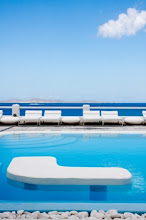The beaches and nightlife are the main reason people visit Mykonos. However, the island also offers a handful of off-beach activities. Architecture buffs will also find plenty to enjoy as Mykonos' buildings are some of the finest in Cycladic-style properties. Travelers also love Little Venice for its restaurants, shopping and postcard views.
- On Mykonos-you can spend the first day and evening enjoying appealing Mykonos town, where a maze of beautiful streets are lined with shops, bars, restaurants, and discos; spend time on one of the splendid beaches; and, if you want to indulge in some hedonism, partake of the wild nightlife." -- Fodor's
- Losing yourself in its colorful alleyways is one of Mykonos Town's cheapest and most exhilarating experiences. A stroll to the kastro area -- behind the Delos ferry pier, at the far left of the port when facing the water -- will take you to the Paraportiani, a cluster of white churches. ... From there, walk through Little Venice, where the Aegean's sapphire waters lap at the legs of cafe tables and chairs." -- Let's go Greece
Historic Attractions
Mykonos is home to a few historical buildings that writers say are worth at least a break from the beach and partying. The most noteworthy of the hundreds of churches in Mykonos, the Paraportiani beach in Chora is actually a collection of four smaller churches. Paraportiani features unique and sloping whitewashed exteriors, and is perched on the top of a rock that looks over the Aegean Sea.
Also in Chora are the six windmills of Kato Myli, which were once used to power Mykonos' granaries. Although they do not function anymore, visitors can get splendid views of the city from within them.
Writers say it would be a shame to visit Mykonos and not take the 30-minute ferry ride from Chora to the island of Delos. The birthplace of the mythical Apollo and Artemis, the famous island is one of the most important archeological sites in all of Greece. Today, visitors can see the island's impressive ruins, including the Temple of Apollo and the ancient theater, and then stop by the fantastic Archeological Museum.
- Visit the small island of Delos, just six miles from Mykonos. Once revered as the birthplace of Apollo and Artemis, the now-uninhabited island has many ancient ruins, including the Temple of Isis with its mosaic-lined marble theater." -- Sherman's Travel
- Mykonos' most famous church is the rocklike Panagia Paraportiani. It comprises four small chapels plus another on an upper storey that is reached by an outside staircase. Visitors should avoid entering during services, unless for genuine worship rather than sightseeing." -- Lonely Planet
Museums
If you are looking for large museums, Mykonos is not really the place for you. What you will find are small kitschy museums -- all in Chora -- that showcase the island's history. Mykonos'
Archeological Museum in Chora features finds from the island of Delos. The
Aegean Maritime Museum nearby houses model ships and other maritime memorabilia, whereas the Mykonos
Folk Art Museum is housed in the 1700s home of a fishing captain.
- The Folk Museum, housed in an 18th-century house, exhibits a bedroom furnished and decorated in the fashion of that period. On display are looms and lace-making devices, Cycladic costumes, old photographs, and Mykoniot musical instruments that are still played at festivals." -- Fodor's
- Save time to visit the island's clutch of pleasant small museums." -- Frommer's
Beaches
The southern shores tend to be far more crowded and developed than their counterparts in the north. The waters are generally calmer and the sands are softer and more pleasant for relaxing. Parties are also centered on this part of the island, especially on beaches like Paradise and Psarou. The northern beaches are naturally wilder and rougher, making them particularly popular for those who want to engage in watersports.
Potential visitors should also note that Mykonos beaches are clothing optional. The amount of nudity varies beach to beach. Southern beaches like Paradise, Paranga and Elia see bathers with less attire, but Ornos Beach is more kid friendly.
- Mykonos has a beach to please everyone. Although all the island's beaches are nude, the degree of nudity depends on where you go." -- Let's Go Greece
Shopping
Shopaholics can find plenty of jewelry, clothing and antiques -- the vast majority of which is locally made. Most of the stores lean toward the luxurious end (with prices that match) and are mainly clustered along the winding streets of Chora.
- Forage for fine silver jewelry -- the best souvenir to bring home -- in the scores of boutiques hidden in Chora's labyrinth of streets. Though most shops are expensive, you can still find the occasional bargain. Take time to shop streetside vendors throughout the city for hand-made crafts and jewelry." --Sherman's Travel
Nightlife
Mykonos is well known throughout Greece for its nightlife. In fact, many Mykonos beach parties start in the day, continue into the night and don't stop until the sun breaks the next day. Paradise and Super Paradise beaches are some of the most popular spots after dark, since they are chock full of bars, clubs and tavernas. If you're looking for something more urban, Chora also has many of Mykonos' top clubs. Within Chora, Little Venice attracts many of the island's gay visitors.
- Drinks in Mykonos are expensive; rarely will they cost less than 9€ ($12), but the good news is, if you are planning to head out at night, there are many supermarkets all over where you can buy a decent bottle of wine for no more than 6€ ($8) and begin your own party in your room, or on your balcony before hitting the town." -- Frommer's





































